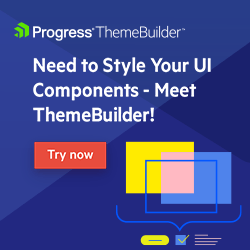How to Streamline Lead Generation with Your Website

Wish you didn’t have to chase new business? Or waste time on prospects who aren’t a good fit? With a lead generation process on your website, you can avoid a lot of this hassle. Plus, it will help you portray a more professional facade for high-quality prospects you want to work with.
You know how clients are. They can tell you what they need—“I need a website,” “I need a logo,” “I need a mobile app”—but it takes quite a bit of prodding to figure out what it is they’re really after. For example:
“I need a lead-generating website that keeps me from having to do cold calls all the time.”
“I need a network of blogs built for $1,000.”
“I need a mobile app done in the next month that allows customers to create shopping lists, find items in the store and compare prices at other stores.”
You could wait until the discovery or consultation call to start pulling this information out of them. But how many times have you done that, only to realize you’re not the right designer or studio for them?
By creating a streamlined, semi-automated lead generation process, you can save both yourself and these prospective clients time if you aren’t a good fit. As a bonus, this process will allow you to come better prepared for those first discussions with right-fit clients.
How to Create a Lead Generation Process via Your Website
Your website can do so much more for your web design business besides advertise your services or store your portfolio. Here’s how you can set it up to streamline lead generation for you:
1. Start with SEO
In order to directly influence leads to visit your website, you need to meet them where they’re at in Google. So it’s a good idea to familiarize yourself with the kinds of questions they’re asking or the searches they’re doing with relation to their website, app or other digital needs.
When planning out your SEO for lead generation, make sure to cover your bases.
For starters, some leads might cut straight to the chase and do a search like “design studio near me” or “web designer minneapolis.” This is where local SEO comes in handy.
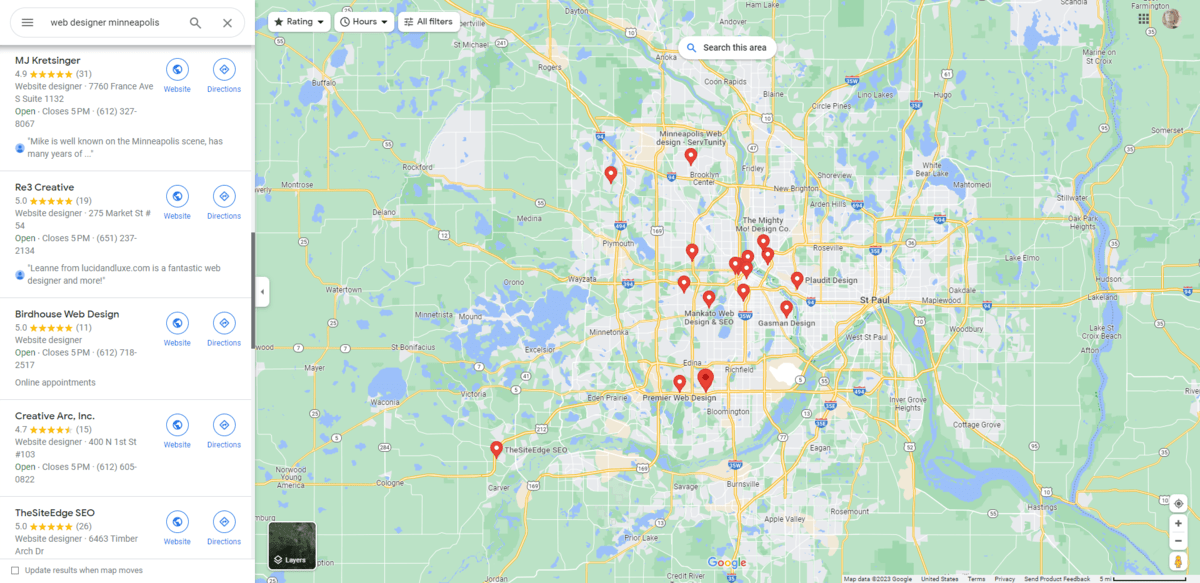
One way to ensure your website ranks in local search and maps results for “near me” queries is to localize the content on your site as well as to add location-specific structured data. This won’t keep you from attracting leads outside of your region. However, if you live in a big metropolitan area, it could be beneficial to tap into that large pool of leads.
Another way to take advantage of local SEO is to create a Google Business page for yourself. That’s how the web designers you see in the screenshot above got listed in maps results. To make yours stand out, you’ll also want to collect client reviews so your star rating pops out at interested leads.
Now, for leads that haven’t quite decided to hire a designer yet, you’ll need to take a different approach to SEO.
For these types of leads, you’ll use informational products (i.e., blogs, videos or even free digital products like checklists or templates) to lure them into your lead generation funnel.
Let’s say you want to attract restaurateurs. What I would suggest is that you take the top questions and concerns you’ve gotten from former restaurant clients and answer them using blog or vlog posts.
For example, when I do a Google search for “does my restaurant website need to be accessible,” one of the top results points to a blog on the website for The Digital Restaurant, a digital marketing agency.
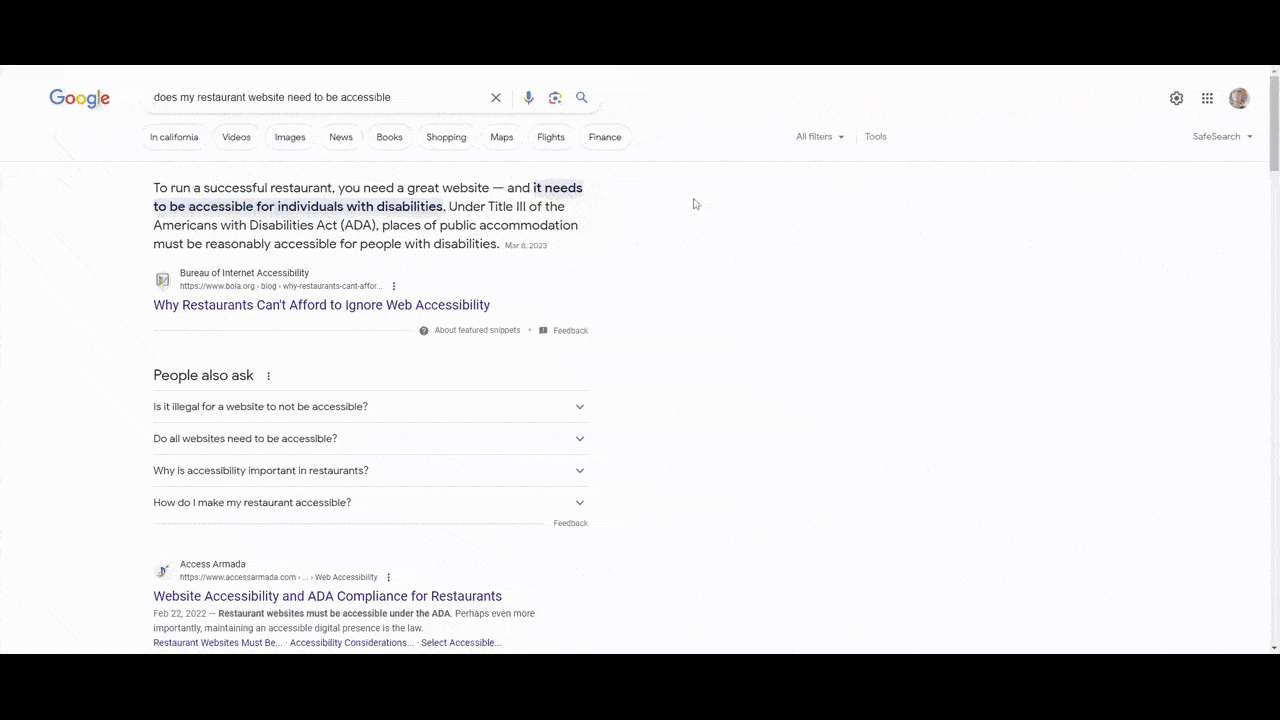
Leads who do this type of search are currently in the information-gathering phase, trying to figure out if they need to build an ADA-compliant website or if they can do it on their own. This post on its own can help them piece together that answer on their own.
However, they might get to the end of that post and decide that it’s just too much work or too difficult to do themselves. When that happens, a no-pressure call to action invites them to schedule a free consultation.
Whether it’s the homepage or header inviting leads to schedule a free consultation or discovery call, or an interior page or post doing it, this is how the lead generation funnel works. You meet the user wherever they’re at on Google (or on social media), convince them to go to your site and then offer a free call.
2. Add a Prospect Questionnaire to Your Site
Before you get to the free call, you have to determine if it’s worth it—for either of you. This is where the prospect questionnaire enters the picture.
Rather than rely on a simple contact form, you’ll ask leads to answer brief questions related to their:
- Business
- Website
- Goals
- Budget
- Timeline
- Special requirements
You can ask for more information if you’d like. It all depends on what sort of information you need in order to make a determination about their fit as a client.
The prospect questionnaire can be handled in a couple different ways.
One option is to replace your contact form with the questionnaire. This is how it’s done on the Contact page of the Your Designer Ash website:

Rather than give leads a bunch of open-ended questions to answer, the questionnaire is much easier to fill out. Pre-written answers are provided for many of the questions, some with context too.
For instance, the question about budget offers four dropdown options. Each contains a price range along with the types of services the prospective client can get for each.
This type of question-and-answer is useful as it helps leads to vet themselves. That said, the label above this particular question invites them to complete the form regardless:
“Help me understand what your budget looks like! If we aren’t a good fit, we probably know someone who is, or have a creative solution to offer! Please get in touch, regardless of budget.”
That’s a nice addition. So rather than leave them feeling as though they can’t afford good design services, they’ve found a resource who can put them in touch with a trusted designer who will work with their budget.
Another way to handle the prospect questionnaire is to do as Idolize Design does.
The general contact form remains on the Contact page. Below, however, are links to three Google Doc questionnaires. This will streamline the intake process as leads only have to fill out the questions pertaining to the service they need:
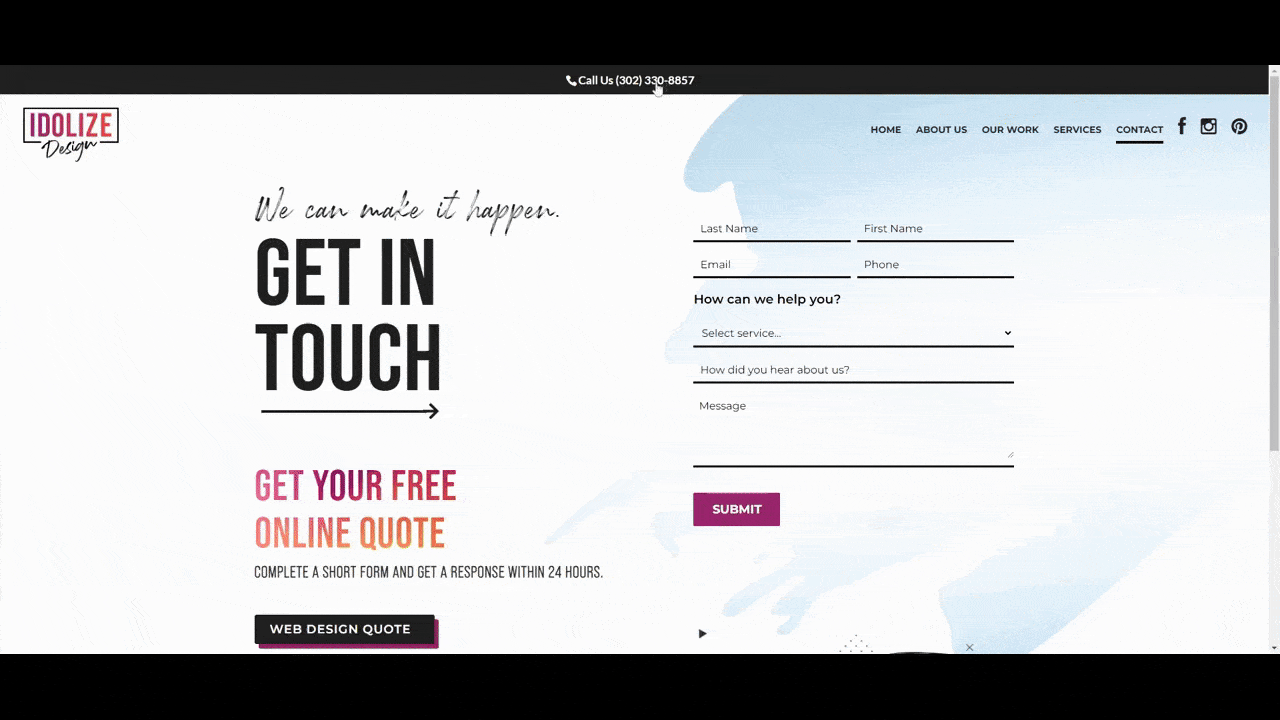
The form for web design services is a three-parter. The first page is all about the business, timeline and budget. My guess is that the others have to do more specifically with the website’s features, technologies and other requirements.
Having a well-built questionnaire is beneficial for a number of reasons.
For starters, prospects who aren’t willing to fill out this form—which takes just a few minutes—aren’t a good fit for you. Imagine how hard it would be to get them to send you their logo in the right format or to provide constructive feedback in a timely fashion if they can’t do this.
So that’s the first way this form will weed out the bad apples.
It will also tell you if a phone call is even worth it. If their budget is $500 and your design services start at $5,000, there’s no point in wasting their time or yours.
Plus, this form will help gather important details about your soon-to-be clients. Rather than spend all that time on the discovery call going through basic questions, let your form take care of it for you. Then you can spend the bulk of the call prepared to talk specifics and maybe even go over an action plan.
I also think these forms instill trust with prospects from the get-go. Having a form that anticipates their needs and clearly breaks everything down is a great way to show them that they’re in good hands.
3. Set up the Phone Call
The next step is to read through the submission and decide if you want to get on the phone with them.
For the ones you want to do a consultation with, you’ll need to do some prep ahead of time. First, put together an email template. Actually, you need to put together two email templates.
One is for the leads that you’re not going to move forward with. Keep the message simple, but do provide a brief explanation of why they’re not a good fit. For example:
Hello Manny,
Thanks for taking the time to fill out my form. While I would like to help with the new app for your business, I’m afraid I can’t. I only design ecommerce websites.
However, I happen to know a designer who does a beautiful job building ecommerce apps. Her name is Shelly and you can check out her portfolio here.
If you have any trouble getting in touch with her or if there’s anything else I can do for you, please let me know.
Ananda
If you can offer an alternative option in your message, that would be nice, though it’s not necessary. Providing a quick explanation of why you’re saying “no” will suffice.
The other email template you should have ready is for the leads you want to schedule a call with. This message will be more straightforward:
Hi Wanda,
Thanks for reaching out and taking the time to fill out my form!
I’d like to have a quick chat about your business, your website goals and how I can help in the long term. I can also give you a bit more information about my process and what to expect if you hire me.
Please use the link below and choose a date/time that works best for you!
Schedule Your Discovery Call
Talk soon,
Jonathan
This one you wouldn’t even need to customize aside from the person’s first name. What you would need to do in advance, though, is ensure your scheduler is set up properly. You can use a tool like Acuity Scheduling, Calendly or Doodle to create it if you don’t have one already.
In the end, you’ll have a page to send leads to that looks like this one for Creative813:
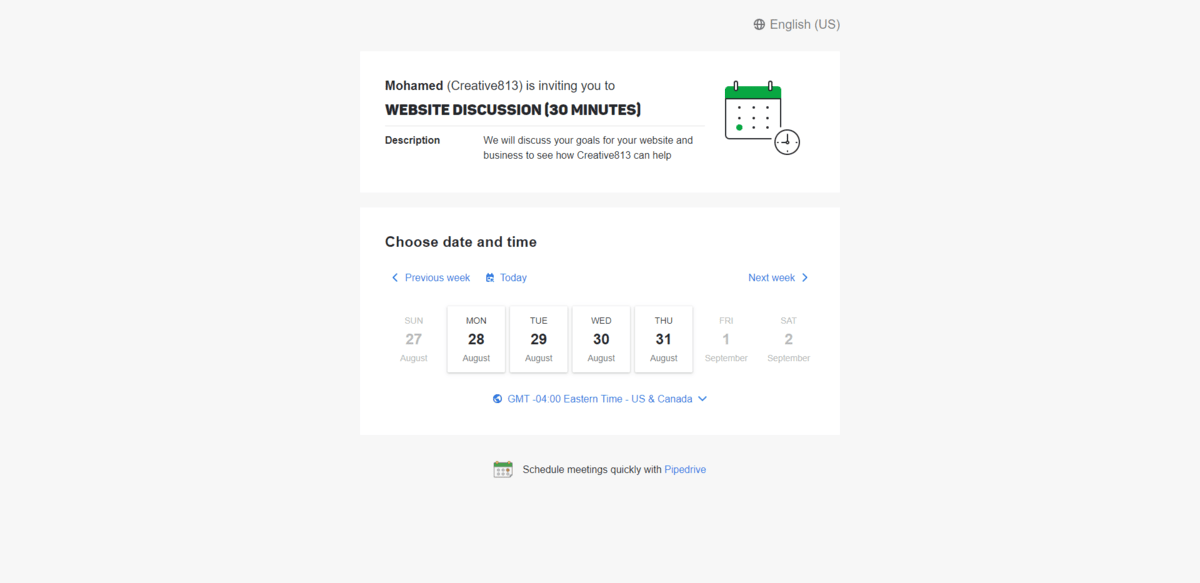
This is a simple scheduler page. It tells the lead who they’ll be meeting with (Mohamed), how long the meeting will be (30 minutes) and what they’ll discuss (website and business goals).
At the bottom, the lead selects the date and time of the call, fills in a few identification questions, and then schedules the meeting on their own. No back-and-forth with you is needed.
The scheduler page for weBOUND Marketing is just as effective:
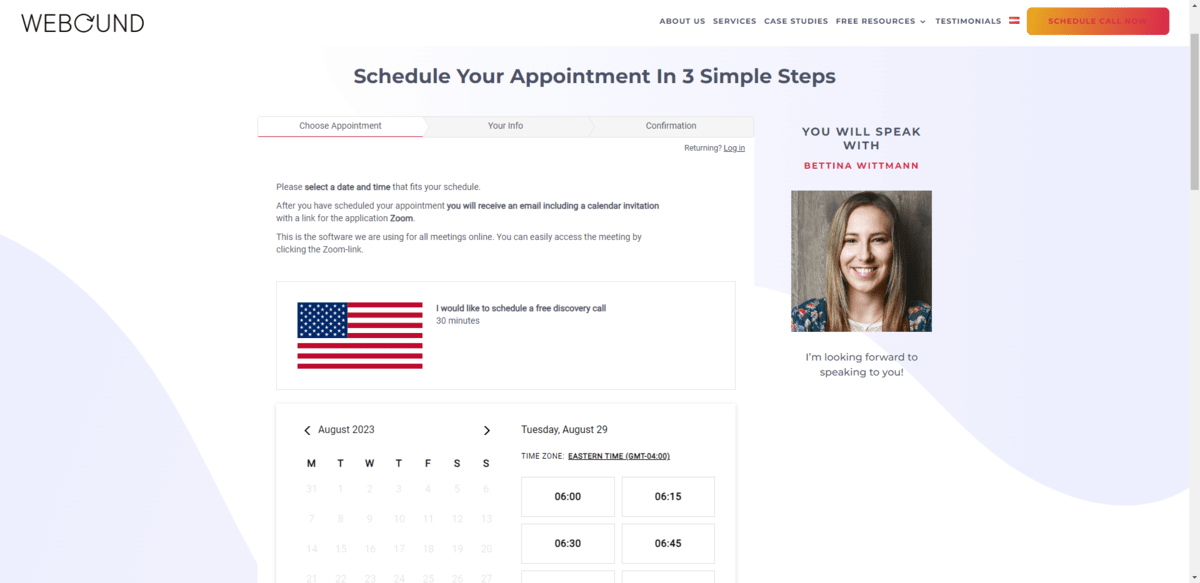
The setup and process is similar. In three steps, the lead will select the date and time of their meeting with Bettina Wittman, they’ll enter some contact information and then they’ll confirm the appointment.
What this scheduler does especially well is it lays out the next steps for leads. Above the scheduling form it reads:
Please select a date and time that fits your schedule.
After you have scheduled your appointment you will receive an email including a calendar invitation with a link for the application Zoom.
This is the software we are using for all meetings online. You can easily access the meeting by clicking the Zoom-link.
By telling them ahead of time what to expect and how you’ll be meeting, you’ll cut down on last-minute issues where the prospect doesn’t understand what Zoom is or how to get into the room. You’ll also show them that you have things taken care of. From giving them an easy-to-use schedule to setting up the Zoom meeting room, you’ve got it all covered.
4. Automate the Follow-up Process
After the phone call is through, you are going to have to decide if you want to work with this client. It’s OK if you don’t. While they might look good on paper, the vibe might have been all wrong during the call.
Perhaps they seemed confused and disorganized, unsure of what it is they actually want. Perhaps they seemed pushy and started asking for free stuff already. Whatever it was, it’s OK to follow up, thank them for their time and politely turn them down (if you didn’t do it during the call).
You should have an email template ready to go for this:
Hello Grant,
Thank you for taking the time to chat with me earlier today.
While your website sounds like an exciting project to take on, I’m afraid I have to decline. If what you seek is a website that ranks on the first search engine results page immediately after launch, I’m not the designer you need.
I’d recommend contacting a design studio with a dedicated content marketing and SEO team as that’s the only way to guarantee those kinds of results in such a short timeframe.
Good luck with everything,
Kristin
While there’s no need to go deep into the specifics about why it’s not a good fit before you talk to a prospect, you should give them some details after you’ve had the call. Even if it’s a mismatch of personality, work style or expectations, find a way to soften the reason so it doesn’t come off accusatory.
For the clients and projects you’re excited to take on, you should have a template ready to send to them as well. Before you get to that point, though, you’ll need to get your proposal ready.
Your proposal is a branded document that includes the following details:
- The problem statement
- Your proposed solution and recommended services
- Project timeline
- Quoted price
- Signature fields
If you have a proposal template, it won’t take long to fill in the specifics. Proposal software like Better Proposals, PandaDoc and Proposify help you generate beautifully branded proposals. You can build them from-scratch or start with a template.
Here’s an example of one of PandaDoc’s fully customizable proposal templates:
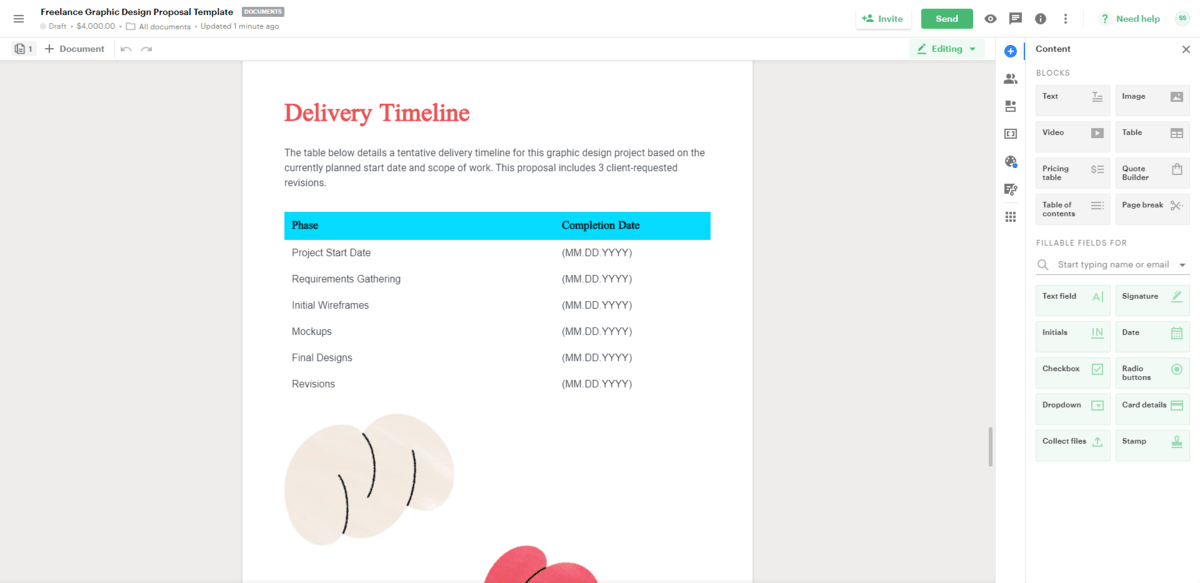
By the way, some contract software includes an option for generating proposals, so check with yours before signing up for a new app.
Once you’ve built your proposal, it’s time to send off your follow-up email to the lead. Here’s an example of how you might write it up:
Hi Marco,
Thanks again for taking time to chat with me!
I’ve reviewed everything we discussed and here is what I’m suggesting:
View the Proposal
Take some time to look over what I’m proposing. I’ve included a revised budget and timeline based on our conversation as well as some alternative options if you wanted to go with the Website + Marketing package versus just a website.
If there’s anything on here you’re unsure of or want to change, let me know. Otherwise, I’ll draw up a contract and we can get started ASAP.
Looking forward to getting started,
Lila
This is the last step of the lead generation process. It’s now in the lead’s hands. If they decide not to move forward, that’s OK. Hold onto the proposal in case they change their minds later on. And if they decide to move forward, then it’s time to kick off your streamlined onboarding process.
Wrapping up
Lead generation doesn’t have to be a time-consuming process. Nor does it need to be one that requires you to spend hours every week, scouring the web for new clients or projects.
Your website is a powerful sales tool. If you set it up right, you can also turn it into a lead generation machine that does a lot of the work for you. Not only that, it’ll help you make a great impression with prospective clients and to start every project off on the right foot.
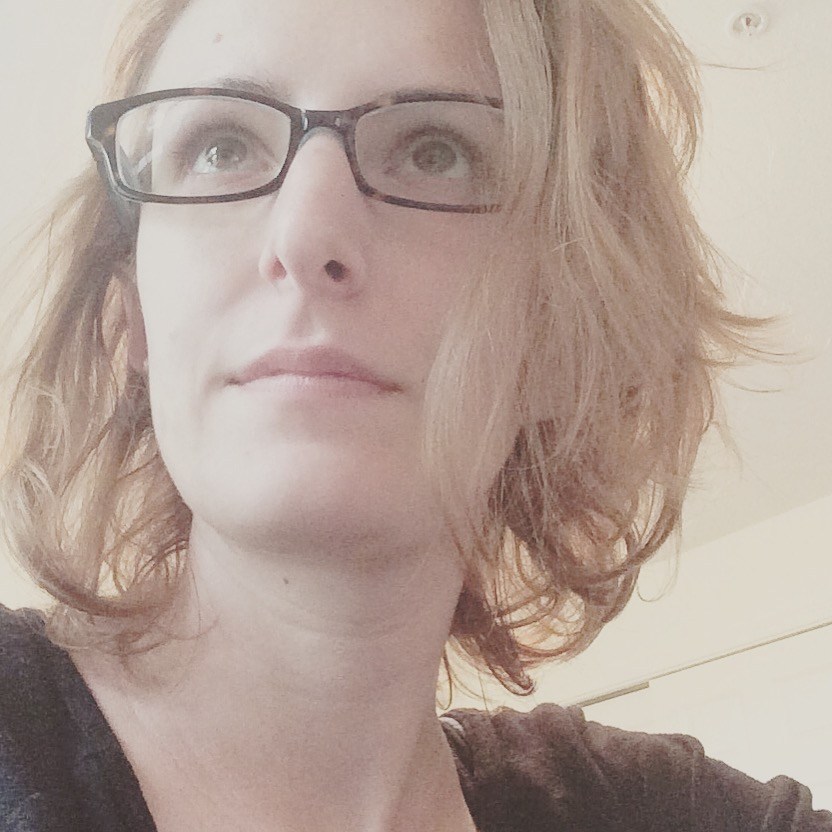
Suzanne Scacca
A former project manager and web design agency manager, Suzanne Scacca now writes about the changing landscape of design, development and software.

